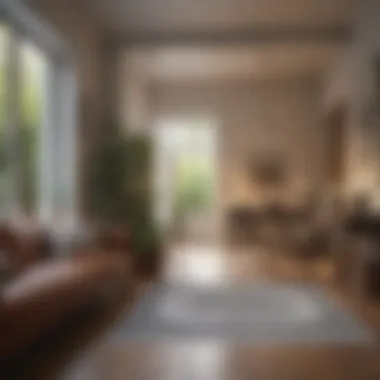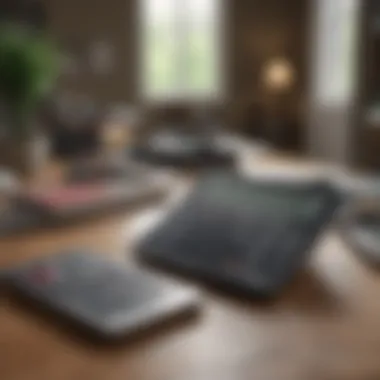How to Measure Square Feet for Room Painting


Intro
Measuring the square footage of a room is a fundamental task for anyone planning to paint. Knowing the size of the space affects both the quantity of paint and the application process. A precise measurement ensures that the paint covers consistently, leading to a professional-quality finish.
This guide serves to clarify how to accurately measure room dimensions. It breaks down the necessary tools, methods, and considerations when dealing with various layouts. Whether you are a homeowner looking to refresh your space or a professional preparing for a project, this article offers insights that can elevate your painting endeavor.
Importance of Accurate Measurements
Accurate measurements are not merely a suggestion; they are the foundation of an effective painting project. Here are a few reasons why precision matters:
- Cost Efficiency: Overestimating the amount of paint can lead to unnecessary expenses. Conversely, underestimating may require last-minute purchases.
- Uniform Coverage: Accurate square footage helps calculate the precise amount of paint needed for even distribution. This minimizes streaks or areas needing touch-ups.
- Time Management: Knowing the correct dimensions allows for proper planning, affecting both the preparation and completion time.
In the following sections, we will discuss various measurement techniques and the essential tools required to ensure you achieve accurate results.
Prelude to Measuring Square Feet
Understanding how to measure square feet is a crucial step before embarking on any painting project. This introduction sets the stage for better comprehension and effective planning, both of which are necessary for achieving a professional-looking result. Accurate measurements help in determining the amount of paint required, which in turn influences budgeting and preparation.
Importance of Accurate Measurements
Knowing the exact square footage allows homeowners and professionals to estimate the quantity of paint needed without overspending. If the measurements are incorrect, it might lead to purchasing insufficient or excessive paint. This can waste time and money. Furthermore, a precise measurement ensures even coverage across surfaces. When the paint is applied evenly, it enhances the overall aesthetic of the room, reducing the chances of repainting due to unevenness or visible brush strokes. Different types of paint have varied coverage; therefore, understanding square footage is vital in this aspect as well.
Overview of the Painting Process
The painting process involves several steps beyond merely applying color to the walls. It starts with planning which includes deciding on colors, finishes, and techniques. However, all these plans must begin with accurate measurements of the spaces involved. After measuring, the next step is calculation of square footage, taking into consideration different aspects like windows, doors, or other architectural features. These factors can impact coverage and the total amount of paint to buy. The preparation phase may also involve surface cleaning and repair before any actual painting starts. Thus, a well-thought-out measurement strategy plays a fundamental role in not only efficiency but also in achieving the desired visual results.
Understanding Square Feet
Understanding square feet is essential when it comes to measuring a room for painting. This knowledge lays the groundwork for accurate calculations and ensures that the painting process proceeds without unnecessary complications. When approaching a painting project, knowing the size of the area is crucial for estimating quantities and costs effectively. Moreover, accurate measurements prevent waste of materials and time, inherently increasing efficiency and satisfaction throughout the project.
Definition of Square Feet
Square feet is a unit of area measurement, commonly used in the United States and a few other countries. It defines the area of a square that has sides of one foot in length. In practical terms, when measuring the dimensions of a room, square feet indicates how much surface area will need painting. For example, if a room measures 10 feet by 12 feet, the total area is calculated by multiplying the two dimensions.
10 feet × 12 feet = 120 square feet
This basic understanding of square feet serves as the foundation for further calculations and estimations during the painting process. It is critical to ensure the results are accurate to prevent miscalculations down the line.
Why Square Feet Matter in Painting
Knowing the square footage of a room directly impacts the painting process. First and foremost, it dictates the amount of paint required. Most paint cans specify coverage per square foot. Therefore, if a painter misjudges the area, they may either run out of paint or, conversely, purchase excessive amounts, resulting in unnecessary expenses.
Additionally, square footage is essential for determining the required tools and time for the project. A more extensive area will naturally take longer to paint and may require more sophisticated equipment like spray guns. Ultimately, understanding square feet is about optimizing every aspect of a painting project. It ensures homeowners and professionals alike can execute their plans with precision.
"Accurate measurements create a solid foundation for success in painting and design projects, facilitating better choices and outcomes."
Tools Required for Measurement
Accurate measurement is critical when preparing a room for painting. Having the right tools ensures that the process goes smoothly and results in optimal coverage. In this section, we will discuss three essential tools often utilized in measuring square footage: measuring tape, laser measures, and notepads with calculators. Each tool offers distinct advantages and can cater to different measurement needs, making them pivotal for anyone looking to achieve precise results in their painting project.
Measuring Tape
A measuring tape is a fundamental tool used in various fields, including construction and interior design. This tool is typically equipped with markings that indicate length in both inches and centimeters, allowing for versatile applications. When measuring the dimensions of a room, a measuring tape enables you to easily capture the lengths of the walls and any alcoves or recesses.
Using a measuring tape is straightforward. Simply extend it from one end of the wall to the other. Make sure to keep it level to avoid inaccuracies. For larger rooms, it might be necessary to enlist a helper to ensure the tape remains taut.
The benefits of using a measuring tape include:
- Cost-effectiveness: Generally, measuring tapes are affordable and widely available.
- Portability: They can easily fit into a toolbox or even a pocket, making them convenient for quick measurements.
- Accessibility: There is little to no learning curve, making them user-friendly for non-professionals.
Laser Measure
A laser measure is a modern alternative to the traditional measuring tape. It employs laser technology to determine distances, allowing for accurate measurements with minimal effort. This tool can be especially useful in larger rooms or spaces where reaching certain points can be cumbersome.
To use a laser measure, simply point the device at the desired edge and activate the measurement function. The device will display the distance instantly. Some models offer additional features such as area and volume calculations, which can further aid in planning your painting project.
Key advantages of laser measures include:
- Speed: Measurements are taken quickly, saving valuable time when preparing for painting.
- Accuracy: They provide precise measurements, reducing the risk of human error.
- Convenience: Many models are compact and lightweight, making them easy to transport.
Notepad and Calculator


While the measuring tape and laser measure allow you to gather the required dimensions, a notepad and calculator serve as important supporting tools. Once you have your measurements, it is essential to record them accurately to avoid confusion later. Using a notepad helps you keep track of your data in an organized manner.
After recording dimensions, you can use a calculator to perform the necessary calculations. Whether you are adding, multiplying, or subtracting, having a calculator ensures that you arrive at the correct square footage needed for your painting project without unnecessary errors.
In summary, keep in mind these points when utilizing a notepad and calculator:
- Organization: Clearly document your measurements to simplify further calculations and planning.
- Verification: Allow for double-checking the numbers before finalizing your estimates.
- Easy Operations: Calculators can also be useful for adjusting your numbers based on varying paint coverage or other factors.
"Accuracy in measurement is the cornerstone of effective painting preparation. The right tools make this task easier and more reliable."
By having these tools handy, you increase your chances of success in your painting project, ensuring every square inch of your room is properly accounted for. Having efficient tools will streamline the initial stages of your planning, enabling you to focus on the creative aspects of your painting.
Methods for Measuring Room Dimensions
Understanding the methods for measuring room dimensions is pivotal in achieving accurate square footage calculations. Accurate measurements are essential to ensure that the quantity of paint required is correctly estimated. This avoids excess purchases and minimizes waste. There are several approaches to measuring room dimensions, each suitable for different room layouts. Knowing the best method can save time and provide clarity in planning your painting project.
Standard Rectangular Room
Measuring a standard rectangular room is straightforward. You begin by measuring the length and width using a measuring tape or a laser measure. For a rectangular space, the formula to calculate square footage is simple:
Square Footage = Length x Width
Here, ensure you measure from base to base, including any fixtures or elements that may protrude. In most cases, it is best to take measurements in feet. If the room is precisely rectangular, this calculation guarantees accuracy in estimating how much paint you will need.
Remember to measure at the longest points to capture any variations that can occur in wall structure. This ensures no areas of the walls are overlooked during the painting process.
Irregularly Shaped Rooms
When it comes to measuring irregularly shaped rooms, the task can become more complex. In such cases, it is effective to break down the room into smaller rectangular or square sections. Each section is measured individually, and then the areas are summed to find the total square footage.
For example, if a room has an L-shape, you can measure each segment:
- Measure the longest part of the L-shape.
- Measure the width of each section.
- Apply the square footage formula to each section and add them together.
In this manner, you account for spaces that standard rectangular formulas cannot address. Be careful when measuring corners and alcoves, as these can alter the overall measurement significantly.
Measuring Corners and Angles
Corners and angles present unique challenges when measuring square footage. Often, walls may not meet at perfect 90-degree angles. This situation requires careful attention. When measuring corners, use a measuring tape to gauge the length of each wall segment leading into the corner. For angles, consider the following:
- Make precise measurements: Use a protractor if the angles are irregular, as this aids in ensuring accuracy in your measurements.
- Document everything: Keep a detailed record of measurements, as any oversight here might lead to a miscalculation of square footage.
After measuring, recheck the angles and segments to confirm that your data is accurate. By systematically addressing each corner and angle, you can maintain the integrity of your room's layout in the final calculations.
Accurate measuring is key to ensuring that you have precisely the right amount of paint required for your project, leading to better outcomes and less waste.
By understanding these methods, you will successfully capture the dimensions of your room, setting you up for an efficient painting project.
Calculating Square Footage
Calculating square footage is a fundamental step in any painting project. It gives an accurate picture of how much paint will be needed, which affects both budgeting and material selection. A correct calculation helps prevent overspending on excess paint or running short during the job. Furthermore, understanding the total area allows for better planning and preparation of the workspace, ensuring all necessary tools and supplies are ready ahead of time.
Basic Formula for Square Footage
To find the square footage of a room, one must use a straightforward formula. For rectangular spaces, the calculation is simple:
- Measure the length: using a measuring tape or laser measure, find the length of the room.
- Measure the width: next, measure the width of the room.
- Apply the formula:Square Footage = Length × Width
For example, if a room is 12 feet long and 10 feet wide, the square footage calculation is:
12 ft × 10 ft = 120 sq ft
This approach works well for standard rectangular rooms. However, for more complex shapes, like L-shaped rooms, break the area into sections and calculate each piece separately. Add the square footage of all sections to obtain the total.
Accounting for Windows and Doors
When calculating square footage, it is crucial to account for windows and doors. These features do not require paint and should be subtracted from the total area. To adjust your calculation:
- Measure windows and doors: Find the height and width of each window and door.
- Calculate areas: Use the same formula:Area of Windows or Doors = Height × Width
- Subtract from total: If you have one window measuring 3 feet by 4 feet and one door measuring 2.5 feet by 6 feet, calculate:Window Area = 3 ft × 4 ft = 12 sq ft
Door Area = 2.5 ft × 6 ft = 15 sq ft
Total Area of Openings = 12 sq ft + 15 sq ft = 27 sq ft - Adjust square footage:Total Adjusted Square Footage = Total Square Footage - Total Area of OpeningsContinuing with our example from above, if the total square footage of the room is 120 sq ft, the adjusted square footage would be:120 sq ft - 27 sq ft = 93 sq ft
"Taking into account windows and doors ensures a more accurate estimation of paint needed for your project."


This adjusted square footage provides a realistic figure for estimating how much paint will be required. Accurate measurements save time and money, making the painting process smoother and more effective.
Special Considerations in Measurement
When measuring square feet of a room to prepare for painting, specific considerations can greatly impact the final calculations. Factors such as ceiling height and architectural features play a crucial role in how much paint you will need and the overall final appearance of the painted space. Understanding these elements ensures a more precise estimate and helps in planning for any needed adjustments.
Ceiling Height
The height of the ceiling is a significant aspect in calculating the area of a room. Standard ceiling heights typically range from eight to ten feet. However, in some homes, ceilings can be much higher, affecting not only the square footage calculation but also the amount of paint required for walls and ceilings.
A higher ceiling means more surface area that needs painting. If the height is irregular or varies throughout the room, it is essential to measure each section accurately. Consider this:
- Higher Ceilings Require More Paint: A room with a ten-foot ceiling requires more paint than one with an eight-foot ceiling, even if the floor area is the same.
- Visual Impact: Higher ceilings can create a feeling of spaciousness, but can also make wall color choices more prominent, affecting how much paint coverage you'll need.
Taking ceiling height into account is not simply about measuring height but also about understanding its significance in the context of the area being painted.
Architectural Features
When measuring for painting, elements such as crown moldings, built-in shelves, and niches can complicate the calculations but are also essential to consider for an accurate assessment. Each of these features can influence how much paint is necessary and the overall result.
Crown Moldings
Crown moldings add a refined finish to a room and impact how paint is applied. They are generally positioned where the wall meets the ceiling. Accurate measurements around crown moldings can help ensure paint does not overlap onto the ceiling. Their significant aspect is that they can create an additional visual layer, necessitating precise attention during painting.
- Key Characteristic: Crown moldings enhance the appearance and can increase the costs slightly due to the complexity of painting around them.
- Benefits: They hide imperfections and create a clean transition between surfaces.
However, it could also mean additional time and tape, leading to higher costs in paint and materials.
Built-in Shelves
Built-in shelves are a popular feature in many homes, providing structural storage solutions that also affect the total area needing paint. When measuring for painting, consider:
- Key Characteristic: Built-in shelves create interruptions in wall space, requiring careful measurement to omit their area.
- Benefits: They can also be painted for continuity in the design theme, requiring additional paint calculations.
It is crucial to measure around these shelves and adjust your calculations for any paint that will go into these features.
Niches
Niches are often architectural elements designed to hold objects or serve as ornamental features. Their contribution to the overall painting project involves:
- Key Characteristic: Niches can provide character but can also complicate overall calculations of square footage.
- Benefits: Painting niches demands finesse and can enhance the aesthetic value of the wall but requires careful attention to not skew overall measurements.
In summary, when calculating square footage for painting, it is important to account for unique room features. This includes understanding their dimensions and influence on both the process and outcome of the painting project. Paying close attention to these considerations will yield a more accurate estimate and a visually appealing finish in the final result.
Finalizing Your Measurements
Finalizing your measurements is a crucial step in preparing for your painting project. This phase ensures that all data gathered is accurate and complete. Any miscalculation at this stage could lead to unintended consequences, such as purchasing the wrong amount of paint or misapplying it. This part of the process also involves confirming that all necessary dimensions are accounted for, including any unique architectural features that might influence how much paint is needed.
Double-Check Your Work
After making your measurements, it is important to double-check your work. This simple but effective step can save you from costly errors. Begin by going through each measurement that you took individually. Cross-reference your measurements against the layout of your room. If possible, involve another person to verify your work. A second set of eyes can catch mistakes that you might overlook, adding another layer of accuracy.
Here are some specific points to consider when double-checking:
- Revisit each area. Measure walls again to confirm your initial readings.
- Compare with your notes. Ensure that what you wrote down matches your measurements.
- Look for inconsistencies. If something seems off, take additional measurements until you find an agreeable number.
This diligence will provide you with a solid base for your paint calculations and minimize the potential for misjudging your supplies.
Documentation for Reference
Keeping accurate documentation is vital for future reference. Collecting your measurements in an organized manner can streamline your painting project and prevent confusion later on. Consider creating a dedicated space where you store this information.
Documentation should include:
- Room dimensions with lengths and widths noted clearly.
- Window and door measurements to aid in natural light considerations and paint calculations.
- Notes on unique architectural features, such as built-in shelves or crown moldings, as these will affect how you approach painting.
You might find it helpful to use digital tools or apps that allow you to input and save room measurements. This not only makes it easier to access the information but also provides a backup in case of lost papers.
Keeping your documentation organized plays a vital role in efficient project management, allowing you to stay focused and ready for the painting phase.
Estimating Paint Quantity


Estimating paint quantity is a crucial step within the painting process. It helps avoid both shortages and excess, saving time and money. A well-thought-out estimation ensures that the project runs smoothly, minimizing interruptions caused by running out of paint mid-application.
To make accurate estimations, one must consider various factors, including total wall area, the number of coats required, and the type of paint being used. Different paints have varying coverage rates, which can drastically affect how much product is needed. Understanding these elements is not just beneficial; it is essential for a successful painting outcome.
Understanding Paint Coverage
Paint coverage is the measurement of how much area a specific quantity of paint will effectively cover. Typically, this is expressed in square feet per gallon. Most paint types provide an estimate on the label, which can be found under the specifications section.
To optimize your coverage calculations, several factors need to be examined:
- Surface Type: Different surfaces absorb paint at different rates. For example, porous surfaces such as drywall may require more paint compared to metal or gloss surfaces.
- Color Change: When changing paint colors, especially from dark to light or vice versa, more coats may be needed. This impacts total quantity required.
- Application Method: Brushes, rollers, and spray methods all yield different results regarding coverage. Rolling often leads to thicker layers compared to spraying.
Calculating Paint Needs
To calculate your paint needs accurately:
- Measure the total wall area: Multiply the room's height by the total length of walls. Subtract the area of windows and doors.For example:
- Determine the coverage rate: Find the coverage rate on the chosen paint can. Assume 1 gallon covers about 350 square feet.
- Calculate required paint gallons: Divide the total wall area by the coverage rate. With our example, it would look like this:Rounding up, one would need 2 gallons to ensure full coverage.
- Height: 9 feet
- Length of walls: 40 feet (assuming no windows or doors for simplicity)
- Total wall area: 9 feet x 40 feet = 360 square feet
In summary, estimating the right amount of paint is vital for managing costs and ensuring an even application. This stage in the painting process is often overlooked but provides a foundation for a successful painting project.
Tips for Efficient Measurement
Efficient measurement is crucial in a painting project. Not only does it ensure the right amount of paint is purchased, but it also prevents waste and optimizes the labor involved. Over or underestimating square footage could lead to mismatched paint colors or extra trips to the store. Therefore, understanding how to measure quickly and accurately is of great importance.
When measuring for painting, there are two primary approaches: doing it solo or involving a team. Each approach has distinct advantages and considerations that can affect the overall efficiency.
Taking Measurements Solo vs. Team Approach
Taking measurements on your own can seem daunting. However, it allows for full control over the process. You can take your time to be as precise as possible without feeling rushed. Measure each wall carefully to capture varying heights or angles. Here are some benefits to consider:
- Flexibility: You choose the time and pace of your work.
- Focus: You can concentrate on details without distractions.
On the other hand, involving a team can drastically improve the speed of the process. With multiple people, you can divide tasks. One can measure while the other notes down the dimensions. Consider these aspects:
- Speed: More hands make the work lighter.
- Collaboration: It can help to have someone to double-check your work, ensuring accuracy.
Using Technology for Assistance
Modern technology greatly enhances the measurement process. Devices like laser measures have become more accessible and can provide quick and accurate readings. This may cut down significant time spent calculating square footage.
Some helpful tools include:
- Laser Measurer: Measures distance accurately with a point-and-click.
- Measuring Apps: Smartphone apps can calculate square footage from measured dimensions.
- Spreadsheet Software: Use spreadsheets to create a summary of dimensions for easy calculations.
Incorporating technology into your measurement strategy is advisable. It not only saves time but also reduces the likelihood of human error.
"Accurate measurements are the foundation of a successful painting project. Investing time in the measuring phase pays dividends when it comes to results."
Keeping these tips in mind can greatly enhance the efficiency of your painting preparation. Choose your approach wisely and leverage technology to ensure precise and prompt measurements.
The End
In summation, the process of measuring square feet for painting is not merely a routine task; it is a crucial step that significantly impacts the efficiency and efficacy of painting projects. Understanding the area you are working with allows for accurate paint estimations, which leads to proper budgeting, avoiding unnecessary expenses, and saving time. An accurate measurement helps ensure that the paint application is even, which is critical for achieving the desired aesthetic results in any room.
Several elements come into play when finalizing measurements, including the calculations for windows, doors, and other architectural features that may disrupt the overall square footage. Taking careful account of these factors is pivotal, not just for estimating paint quantity but also for achieving a high-quality finish.
Proper documentation and attention to detail throughout the measuring stage pave the way for a more organized and successful painting process. When all factors are considered, you can approach your project with confidence, knowing that your preparations are thorough.
"An ounce of prevention is worth a pound of cure." In the context of painting, this saying emphasizes the importance of getting your measurements right before commencing any paint job.
Recap of Key Points
The following points encompass the vital aspects covered throughout the article:
- The importance of precise measurements in painting projects.
- Understanding the definition and relevance of square footage.
- The various tools required for accurate measurements, such as measuring tapes and laser measures.
- The methods for measuring both standard and irregularly shaped rooms.
- How to calculate square footage by applying basic formulas and accounting for openings like doors and windows.
- Special considerations that need attention, including ceiling height and unique architectural features.
- The necessity of finalizing measurements through double-checking and effective documentation.
- Guidance on estimating the quantity of paint needed based on calculated area.
- Tips for efficient measurement, whether working solo or in a team.
Each of these points serves as a stepping stone for preparing effectively for a painting job, thereby streamlining the overall process.
Next Steps in Painting Preparation
After confirming and finalizing your measurements, the next logical steps in painting preparation include:
- Selecting the Right Paint: Research the types of paint available and choose one that fits your desired finish and durability.
- Gathering Supplies: Collect all necessary tools, brushes, rollers, tape, and drop cloths to ensure a smooth workflow.
- Choosing a Color Palette: Experiment with color samples or swatches to determine which shades will be suitable for your space.
- Preparing the Surfaces: Ensure that your walls are clean, patched, and primed as required before applying any new paint.
- Planning the Painting Schedule: Organize a timeline to complete the job effectively, considering the number of coats needed and drying times.
- Safety Considerations: Assess the area for necessary safety measures, such as ventilation and protective gear for health and safety.
By undertaking these steps, you create a systematic approach to painting, fortifying your efforts and leading to successful outcomes in enhancing your living or working space.















